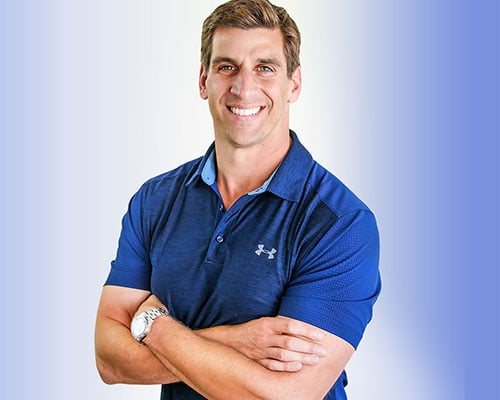How often do you hear questions like:
- “How much protein should I have?”
- “What do you think about intermittent fasting?”
- “Should I follow the [insert name of current popular diet] to lose weight?”
It’s not surprising.
Nutrition and fitness certainly can’t exist without each other. As a nutrition specialist, you are going to be asked questions concerning nutrition. It’s inevitable.
However, giving advice can be a slippery slope and it’s vital to understand legalities and your scope of practice around nutrition as a fitness professional.
Although each state is different and it’s important to confirm the laws and rules of your own state, here’s what you CAN do to better help your clients.
Ready to earn some CEUs? Browse our course selection on nutrition.
Commit Yourself to Continuing Education Efforts
Knowledge is power. Educate yourself on nutrition so you can confidently coach your clients to change.
With the NASM Certified Nutrition Coach course you have a solid foundation of credible information and with this information you can offer general nutrition guidance and behavioral change strategies to your clients. Of course it’s encouraged to also partner with a dietitian to bolster information and both benefit from the synergistic relationship.
5 Strategies to Master the Basics
Just because you’re giving ‘general’ nutrition information, doesn’t take away the importance of that information. If anything, we all should go back to the basics. There is something powerful about simplicity and its effectiveness.
1. Get Familiar with Reputable Websites
MyPlate.gov offers a great starting point. Show your clients how to navigate the website, emphasizing each food group.
Explain serving sizes, what’s included with each food group, and portion recommendations. Calorie specific plans with food targets can be found there as well, which takes a lot of weight off your shoulders when it comes to ‘meal planning’ as this is often a question from clients and is that general information that falls within your scope since you’re simply sharing the government guidance.
Or you know what? If you want to guide clients with the meal plans through that website but educate and inform them while supporting those recommendations with time-tested strategies– show them your’s (and their) hands.
Seems silly, but uber effective and well within your scope since it’s never awkward to pull your hands out at the dinner table, and can be used to easily and appropriately estimate proper portion sizes.
The best part? It doesn’t overcomplicate things. In general, your fist can estimate one cup servings, your palm is about 3-4 oz, thumb is 1 tbsp, and finger nail about 1 tsp. See? Easy right. Encourage your clients to watch their portions and utilize this simple tool.
2. Review the USDA Dietary Guidelines for Americans
No, I don’t mean all 72 pages (but props to you if you want to). The main takeaway from the guidelines is to educate what foods to increase and what foods to decrease in one’s diet. Nutrition is a hot topic in the media and your clients will often be confused.
Be prepared for all kinds of questions and simply give guidelines instead. Based on the 2015-2020 guidelines, foods to increase in the diet are fruits, vegetables, grains, fat-free or low-fat dairy, a variety of protein and plant proteins, and plant-based, high quality oils.
It’s not magic, it’s not exciting, but it’s effective and as a trainer, following these guidelines that are published online by valid, scientific experts, is well within your scope. Further, when clients follow qualified and credible information, coupled with appropriate training, results will speak for themselves.
3. Discuss Healthy Eating On-the-go
Busy schedules mean many people are constantly eating on-the-go. Being proactive is a crucial skill to teach clients. Whether this means meal prepping for the week, washing off fruits/veggies for easy access, or packing a healthy snack in their bag.
Discussing strategies when going out to eat can be helpful such as boxing up half their plate, swapping fruit instead of fries with their meal, and eating slower at meal times, to name a few.
Consider providing lists of smart, super simple on the go snacks that combine fiber, protein and healthy fats as well as listening to their ideas so it’s a team effort.
4. Help Your Clients Learn Healthy Cooking and Food Preparation Techniques
Cooking and food preparation is half the battle. It can seem intimidating at first, if clients aren’t used to cooking regularly.
Be supportive and reassure them cooking can be incredibly simple. This can also be a great time to discuss foods, using the information gathered from within the NASM-CNC program along with reputable websites, like those highlighted earlier.
Start with what they currently enjoy eating or what they enjoyed eating as they were growing up.. Find fun recipes (perhaps 5 ingredients or less recipes to start), and videos on how to prepare the food.
Encourage healthier food prep strategies and consider even following along similar online recipes. As an added source of revenue, we’ve even heard of trainers and gyms partnering with local chefs to offer group cooking online for their clients. Any of these strategies can not only improve results, but also improve your relationship and connection with your clients.
Again, if you’re not comfortable in the kitchen yourself, consider reaching out to a registered dietitian who may be or a local chef who could serve as a partner to provide this added value to your clients.
5. Take Clients to the Grocery Store
Consider grocery shopping with your clients (or in this day and age, virtual grocery shopping with them). This is also a great opportunity to teach your client how to read a food label, which again, is well within your scope and can go a long way in terms of adding value.
Showing and discussing labels with clients can of course also be done online; most importantly the attention and devotion you give to their results will go a long way in terms of success.–
Takeaways
Although it has the potential to get messy considering scope of practice, don’t avoid the topic of nutrition with clients.
Using information provided from within the NASM-CNC is a great foundation, which of course can be supplemented by reputable websites, and then also supported with a partnership you create with a Registered Dietitian who will be able to complement your offerings.
Remember, it’s difficult to go wrong if you stick with general guidelines and keep things simple. And, always, refer to a dietitian if you need individualized meal planning, nutritional assessments, specialty diets, or nutrition counseling.

















